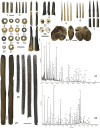Early evidence of San material culture represented by organic artifacts from Border Cave, South Africa
- PMID: 22847420
- PMCID: PMC3421171
- DOI: 10.1073/pnas.1204213109
Early evidence of San material culture represented by organic artifacts from Border Cave, South Africa
Abstract
Recent archaeological discoveries have revealed that pigment use, beads, engravings, and sophisticated stone and bone tools were already present in southern Africa 75,000 y ago. Many of these artifacts disappeared by 60,000 y ago, suggesting that modern behavior appeared in the past and was subsequently lost before becoming firmly established. Most archaeologists think that San hunter-gatherer cultural adaptation emerged 20,000 y ago. However, reanalysis of organic artifacts from Border Cave, South Africa, shows that the Early Later Stone Age inhabitants of this cave used notched bones for notational purposes, wooden digging sticks, bone awls, and bone points similar to those used by San as arrowheads. A point is decorated with a spiral groove filled with red ochre, which closely parallels similar marks that San make to identify their arrowheads when hunting. A mixture of beeswax, Euphorbia resin, and possibly egg, wrapped in vegetal fibers, dated to ∼40,000 BP, may have been used for hafting. Ornaments include marine shell beads and ostrich eggshell beads, directly dated to ∼42,000 BP. A digging stick, dated to ∼39,000 BP, is made of Flueggea virosa. A wooden poison applicator, dated to ∼24,000 BP, retains residues with ricinoleic acid, derived from poisonous castor beans. Reappraisal of radiocarbon age estimates through bayesian modeling, and the identification of key elements of San material culture at Border Cave, places the emergence of modern hunter-gatherer adaptation, as we know it, to ∼44,000 y ago.
Conflict of interest statement
The authors declare no conflict of interest.
Figures


Comment in
-
Arrow poisons in the Palaeolithic?Proc Natl Acad Sci U S A. 2012 Nov 27;109(48):E3290; author reply E3291-2. doi: 10.1073/pnas.1213860109. Epub 2012 Oct 23. Proc Natl Acad Sci U S A. 2012. PMID: 23093666 Free PMC article. No abstract available.
References
-
- Watts I. The pigments from Pinnacle Point Cave 13B, Western Cape, South Africa. J Hum Evol. 2010;59:392–411. - PubMed
-
- Henshilwood CS, et al. A 100,000-year-old ochre-processing workshop at Blombos Cave, South Africa. Science. 2011;334:219–222. - PubMed
-
- Henshilwood CS, d’Errico F, Watts I. Engraved ochres from the Middle Stone Age levels at Blombos Cave, South Africa. J Hum Evol. 2009;57:27–47. - PubMed
Publication types
MeSH terms
Grants and funding
LinkOut - more resources
Full Text Sources
Miscellaneous

